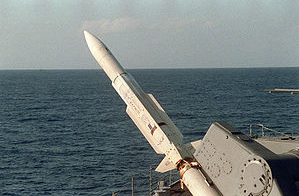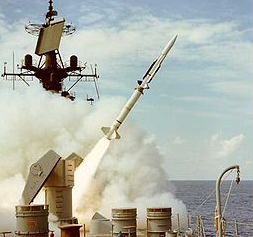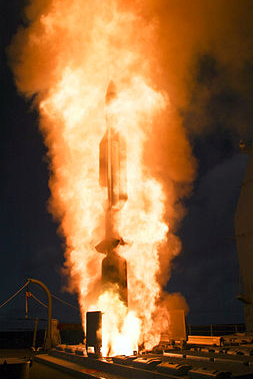
| RIM-67 Standard ER | |
 |
|
| Type | extended range surface-to-air missile with anti-ship capability |
| Place of origin | United States |
| Service history | |
| In service | RIM-67B: 1981, RIM-156A: 1999 |
| Unit cost | $409,000 |
| Specifications | |
| Weight | 2,980 lb (1,350 kg) |
| Length | 26.2 ft (8.0 m) |
|
|
|
| Warhead | Proximity fuse, high explosive 137 lb (62 kg) continuous rod, later blast fragmentation |
|
|
|
| Engine | Two-stage, solid-fuel rocket; sustainer motor and booster motor |
| Wingspan | 5 ft 2 in (1.57 m) |
|
Operational range |
65–100 nmi (120–190 km) |
| Flight ceiling | 80,200 ft (24,400 m) |
| Speed | classified |
|
Guidance system |
Inertial/SARH |
|
Launch platform |
Surface Ship |
The RIM-67 Standard ER (SM-1ER/SM-2ER) is an extended range surface-to-air missile (SAM) and anti ship missile originally developed for theUnited States Navy (USN). The RIM-67 was developed as a replacement for the RIM-8 Talos, a 1950s system deployed on a variety of USN ships, and eventually replaced the RIM-2 Terrier as well since it was of a similar size and fit existing Terrier launchers and magazines. The RIM-66 StandardMR was essentially the same missile without the booster stage, designed to replace the RIM-24 Tartar. The RIM-66/67 series thus became the US Navy's universal SAM system, hence "Standard Missile."
RIM-67A SM-1 Extended Range
The RIM-67A (SM-1ER Block I) was the Navy's replacement for RIM-8 Talos missile. Improved technology allowed the RIM-67 to be reduced to the size of the earlier RIM-2 Terrier missile. Existing ships with the Mk86 guided missile fire control system, or "Terrier" were adapted to employ the new missile in place of the older RIM-2 Terrier missile. Ships that switched from the RIM-2 Terrier to the RIM-67A were still referred to as Terrier ships even though they were equipped with the newer missile.
RIM-67 and RIM-156 SM-2 Extended Range
The second generation of Standard missile, the Standard Missile 2, was developed for the Aegis combat system, and New Threat Upgrade program that was planned for existing Terrier and Tartar ships. USS Mahan (DDG-42) served as the test platform for the development of the CG/SM-2 (ER) missile program project. The principal change over the Standard missile 1 is the introduction of inertial guidance for each phase of the missile's flight except the terminal phase where semi-active homing was retained. This design change was made so that missiles could time share illumination radars and enable equipped ships to defend against saturation missile attacks.
Terrier ships reequipped as part of the New Threat Upgrade were refit to operate the RIM-67B (SM-2ER Block II) missile. However, Aegis ships were not equipped with launchers that had space enough for the longer RIM-67B.
The RIM-156A Standard SM-2ER Block IV with the Mk 72 booster was developed to compensate for the lack of a long range SAM for the Ticonderoga-class of Aegis cruisers. The Mk72 booster allows the RIM-156A to fit into the Mk41 guided missile launch system. This configuration can also be used for Terminal phase Ballistic Missile Defense.

An SM-2ER on the rail insideUSS Mahan (DDG-42).
There was a plan to build a nuclear armed standard missile mounting a W81 nuclear warhead as a replacement for the earlier Nuclear Terrier missile(RIM-2D). The USN rescinded the requirement for the nuclear armed missile in the 1980s, and the project was canceled.[2]
The Standard can also be used against ships, either at line-of-sight range using its semi-active homing mode, or over the horizon using inertial guidance and terminal infrared homing.[3]
A new generation of Standard extended range missiles is expected to become operational in 2011. This missile is covered in a separate article. Please see RIM-174 Standard ERAM for details.
Operational history
During the Iran–Iraq War (1980–1988) the United States had deployed Standard missiles to protect its navy, as well as other ships in the Persian Gulf from the threat of Iranian attacks. According to the Iranian Air Force, its F-4 Phantom IIs were engaged by SM-2ERs but managed to evade them, with one aircraft sustaining non-fatal damage due to shrapnel.[4] During the same war United States navy accidentally shot down an Iranian civilian airliner, Iran Air Flight 655using two SM-2 missiles.
On April 18, 1988, during Operation Praying Mantis, the USS Simpson (FFG-56) fired four RIM-66 Standard missiles and the USS Wainwright (CG-28) fired two RIM-67 Standard missiles at Joshan, an Iranian (Combattante II) Kaman-class fast attack craft. The attacks destroyed the Iranian ship's superstructure but did not immediately sink it, although it did subsequently go down.
Deployment

RIM-67A Launching

RIM-67 intercepting Firebee drone in 1980 test.
RIM-67 Standard was deployed on ships of the following classes, replacing the RIM-2 Terrier, and it never was VLS-capable. All of the ships used theAN/SPG-55 for guidance. The Mk10 guided missile launching system was used as the launching system. New Threat Upgrade equipped vessels operated the RIM-67B which used inertial guidance for every phase of the intercept except for the terminal phase where the AN/SPG-55 radar illuminates the target.
• USS Long Beach (CGN-9) SM-1ER later SM-2ER with NTU.
• Farragut class destroyers SM-1ER later SM-2ER.
• Leahy class cruisers SM-1ER later SM-2ER with NTU.
• USS Bainbridge (CGN-25) SM-1ER later SM-2ER with NTU.
• Belknap class cruisers SM-1ER later SM-2ER with [.
• USS Truxtun (CGN-35) SM-1ER later SM-2ER with NTU.
• Italian cruiser Vittorio Veneto (550) SM-1ER Only.
The RIM-156 Standard Block IV, is a version that has been developed for Aegis Combat System it has a smaller compact sized booster stage for firing from the Mk41 Guided missile launch system. Like the earlier RIM-67B it employs inertial/command guidance with terminal semi-active homing.
• Ticonderoga class cruisers (VLS units only)
• Arleigh Burke class destroyers
The last vessel to operate the RIM-67 was the Italian cruiser Vittorio Veneto (550) which was retired in 2003. The RIM-174 Standard ERAM or Standard Missile Six has superseded the RIM-156A in production. The RIM-156A remains in service as of 2010.
Surface to air variants

A RIM-156A (VLS version of the RIM-67) launching from a VLS cell on the USS Lake Erie in 2008.
| Designation | Block | Notes |
|---|---|---|
| RIM-67A | SM-1ER Block I |
Terrier Upgrade Essentially identical to the corresponding SM-1MR missile, except for the propulsion Atlantic Research Corp. MK 30 solid-fuel rocket sustainer motor Hercules MK 12 booster MK 51 continuous-rod warhead |
| RIM-67B | SM-2ER Block I |
New Threat Upgrade. Entered service in 1980. Inertial Guidance System Monopulse seeker for terminal homing |
| RIM-67C | SM-2ER Block II |
New Threat Upgrade Introduced MK 70 booster, almost doubling the effective range MK 115 blast-fragmentation warhead |
| RIM-67D | SM-2ER Block III |
New Threat Upgrade MK 30 MOD 4 sustainer engine MK 45 MOD 8 proximity fuze (also known as TDD - Target Detection Device) |
|
RIM-156A (ex-RIM-67E) |
SM-2ER Block IV |
Designed for Aegis VLS ships. Initial Operational Capability was declared in August 1999. Finless MK 72 booster that uses thrust-vectoring control MK 45 MOD 10 TDD, for improved performance against high-performance, low-RCS threats Guidance and control modifications for better performance in severe ECM environments A developmental step toward the Navy Area Theater Ballistic Missile Defense (NATBMD) missile |
| RIM-156B | SM-2ER Block IVA |
Designed for modified Aegis VLS ships capable of tracking both TBM's and aircraft. Dual-mode RF/IIR (Radio Frequency/Imaging Infrared) seeker Upgraded MK 125 warhead package Enhanced autopilot for the anti-TBM mission Cancelled as a part of the whole NATBMD program in December 2001. |



















